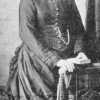A sign on the bridge over the River Frome at Lower Bockhampton serves notice that “anyone wilfully injuring the bridge will be guilty of felony and upon conviction liable to be Transported for Life.” People were transported for a lot less serious offences than that and many people sentenced to death for more serious crimes had their sentences commuted and were transported instead.
The idea of being rid of troublesome citizens by transporting them beyond the seas was around long before Britain commenced despatching its felons to Australia. In 1597 during the reign of Queen Elizabeth I an Act (39 Eliz C.4) was passed entitled “An Acte for Punyshment of Rogues, Vagabonds and Stray Beggars.” It allowed for people to “be banished out of this realm” and went on to say “shall be conveyed to such parts beyond the seas as shall be assigned by the Privy Council.” And for good measure declared if a “rogue so banished” returned to England without permission he would be hanged.
Law enforcement during the 17th and 18th centuries was an uncertain business. Anyone who thinks the present British government’s efforts to privatise the prison service are a new idea is mistaken: half the prisons in England were privately owned then. There was no police force. Employing Watchmen was, on the whole, a futile enterprise as most were open to accepting the offer of a small bribe to turn the other way and those given the job were often elderly and stood little chance of apprehending a fit young criminal.
Detection was also in the hands of the private sector. Thief takers – an early incarnation of the private detective – would seek out thieves and other criminals and bring them before a magistrate for a reward. Getting caught was not all bad news for the criminal: in many cases a criminal would come to an arrangement with his victim to repay him or do some work for him rather than face prosecution. This was not an unattractive option for the victim who, if he proceeded to prosecute, would have to pay all the costs involved. Nevertheless, large numbers of people were incarcerated in the country’s jails.
Using the 1597 Act, transportation of groups of criminals got under way in the early 17th century: Sir Thomas Dale, Marshal of Virginia, took 300 “disorderly persons” with him in 1611 and it was not long before he was asking for more convict labour, claiming 2000 were needed.
A new Act (4 Geo 1, C.11) was passed early in the 18th century which provided that minor offenders could be transported for 7 years to America while men on commuted capital sentences, that is having enjoyed the King’s mercy, might be sent for 14 years. The courts did not have a wide selection of punishments to hand down and were often faced with the choice of letting a criminal off or passing the death sentence.
The merits of transportation from the Government’s point of view were that it preserved the Royal Prerogative of Mercy – the felon was left alive; the felon was removed from the realm as effectively as if he had been hanged; It got rid of the prison as well as the prisoner and it provided a labour force to be used in the colonies.
From the middle of the 18th century Britain’s population increased dramatically. The population of London doubled between 1750 and 1770. Young men turned to thieving to make a living. For 60 years during the 18th century 30,000 people were sent to America; convicts were shipped off to face a life of slavery at the rate of about 500-600 a year and few if any returned. The King frequently used his royal prerogative and it was not at all unusual for a death sentence to be commuted. A cynic might think a corpse hanging from the gallows was a deterrent to others but the reprieved man was a long-term asset to be used to build the American colonies. This shameful traffic in humankind kept England’s jails from overflowing.
On August 25th 1768 Capt. Cook set sail from Plymouth and a little over a year later was off the coast of New Zealand where he proceeded to sail his ship Endeavour round both islands. On March 31st 1770 Capt. Cook and his crew were ready for the homeward voyage. On April 19th 1770 a new coastline was discovered and on August 21st 1770 Cook formally claimed Australia for King George III.
In London the new colony was not uppermost in the minds of the politicians who had their hands full trying to head off armed rebellion in America. It was this more taxing matter that was concentrating the mind of the British Prime Minister, the recently ennobled Frederick, Lord North. Matters in America came to a head with the Declaration of Independence on the 4th of July 1776. At a stroke the transportation of convicts to North America was brought to a full stop and very shortly Britain’s jails were at breaking point.
That year Lord North drew up legislation that was to become known as ‘The Hulks Act’ (16 Geo.111, C. 43.) Hulks, old troop transports, their rigging gone, were dotted along the Thames and some southern ports, and were to become home to convicts sentenced to be transported, until the government could find somewhere to send them. The number of convicts being held in this way was increasing by about a thousand annually.
As the situation worsened and the government realised that the door to North America was firmly closed to them a House of Commons Committee was set up in 1779 to decide what was to be done. Hope lingered in some of the more optimistic corners of government that something would turn up to resolve the American problem, but this was not to be. Lord North resigned in 1782 and briefly trod London’s corridors of power again as the Home and Colonial Secretary between March and December 1783.
His successor in that office, Lord Sydney, on appointment faced a clamour for action to be taken to deal with the problem of the terrible overcrowding in the prisons and on board the hulks; the situation was becoming more pressing with each passing day. A new Act (24 Geo.III.C.56) was drafted to allow transportation to places other than America and this entered into law in August 1784.
It was someone from outside of the administration, ironically American born, who in 1783 presented a commercial proposition to the government concerning Australia. At the time Lord North was in charge of Home and Colonial Affairs and he dismissed it. James Matra, later hearing the government was urgently looking for somewhere to send the convicts, altered the slant of his proposal and re-submitted it to Lord Sydney. Serious consideration was given to transporting the convicts to a settlement on the south west coast of Africa and for a while Australia wasn’t a contender.
William Pitt the younger was now Prime Minister and he was under increasing political pressure especially from some independent members of parliament representing constituencies where some of the hulks were berthed.
After further consideration the Botany Bay or Australian option was formally approved by the cabinet. The Admiralty was told of the decision on the 31st of August 1786 and instructed to commission the fleet: Captain Arthur Phillip was appointed “Governor of our territories called New South Wales” and received his commission from King George III on 12th October 1786.
The first fleet sailed from Portsmouth early on the 13th May 1787 and arrived at Botany Bay on 18th January 1788. Convicts continued to be transported to Australia for a further 70 years.
Those who survived the voyage were to face a harsh disciplinary regime, near starvation, and we know not what other horrors. There were men, women and children all enduring the same fate irrespective of whether they were guilty of a petty or serious crime. Their guards did not fare any better. The experience was a little easier for later arrivals. It is incredible that out of this hell has grown the great nation we know and respect today.



